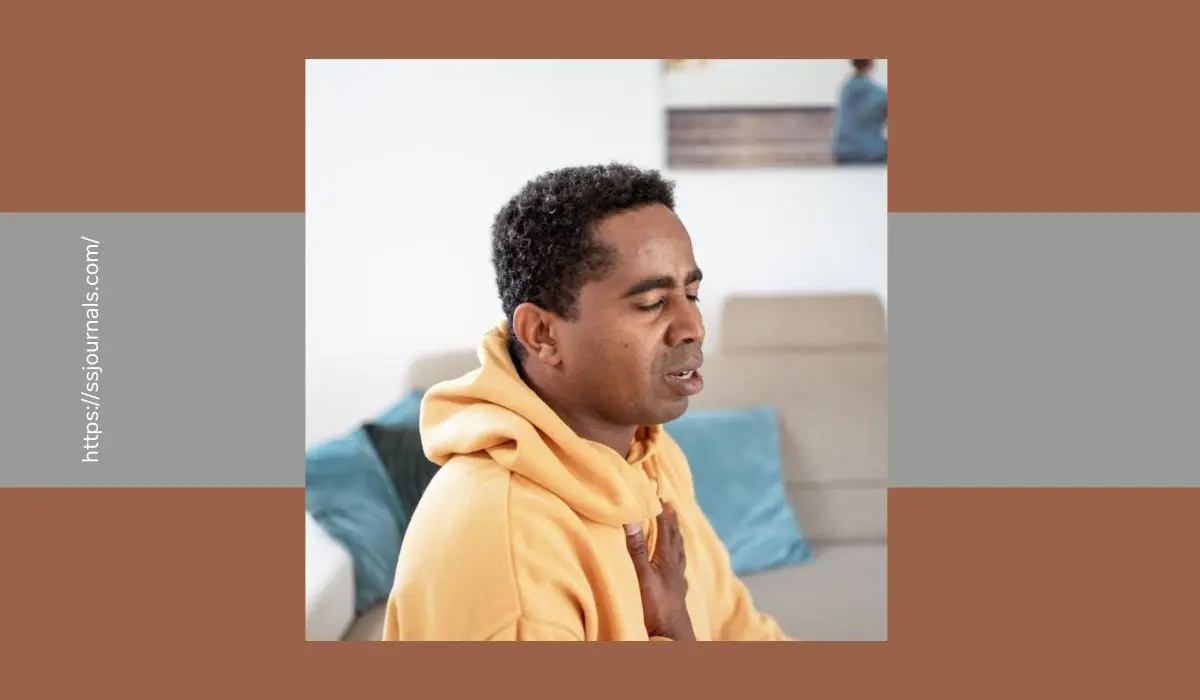Chest pain is a common complaint that can be caused by a variety of conditions, some of which are minor while others can be life-threatening.
Pain on the right side of the chest has some distinct potential causes that are important to recognize. Identifying the origin and type of chest pain can help guide appropriate treatment.
What Leads To The Cause Of Right Side Chest Pain?
There are several potential underlying causes of right-sided chest pain. The source of the pain can be related to organs and structures found on the right side of the chest.
One of the most concerning potential causes is an issue with the heart. Angina, which is chest pain caused by insufficient blood flow to the heart, can sometimes manifest as right-sided chest pain.
A heart attack affecting the right side of the heart can also lead to right-sided chest pain. The tissue of the heart itself lacks pain receptors, but the sac surrounding the heart called the pericardium has nerves and can generate pain.
Lung issues on the right side, including inflammation, blood clots, pneumonia, or collapsed lung can generate right-sided chest pain as well. The lungs have visceral pleura that contain pain receptors. Inflammation of the pleura, called pleuritis, results in sharp chest pain.
Problems with organs in the upper right abdomen can radiate pain up to the right chest. This includes gallbladder issues like cholecystitis or gallstones, as well as liver conditions like hepatitis. The diaphragm separates the chest from the abdomen but shares nerves such that pain from below can be felt above.
Muscle strains and bone issues involving the ribs, chest muscles, or sternum can also manifest as right-sided chest pain. Fractured or bruised ribs are a common cause. Shingles, which is caused by the chickenpox virus, can affect the nerves of the right chest wall as well.
Signs & Symptoms Of Having Right Side Chest Pain
The characteristics of right-side chest pain can provide clues to help discern the origin. Sharp, stabbing chest pain that worsens with breathing in is very concerning for a lung or pleural issue like pneumonia or pulmonary embolism. A sharp pain that changes with body position can indicate an injury to the muscles or bones of the chest wall like fractured ribs.

Crushing, pressure-like pain that radiates down the right arm is suggestive of heart-related pain like a heart attack. If it develops during exercise and goes away with rest, it could be angina. Pain from gallbladder or liver issues may start as a dull ache but become sharp and severe. It may be accompanied by nausea, vomiting, or abdominal pain.
Coughing, difficulty breathing, and fever may accompany chest pain from lung infections or pneumonia. Pain that follows a rash could be from shingles. Known risk factors like recent trauma to the chest, previous heart conditions, or gallstones also provide clues to the origin of the pain.
Seeking prompt medical evaluation for right-sided chest pain allows testing to pinpoint the cause, especially when heart issues are suspected. An EKG and cardiac enzymes can diagnose a heart attack, while a chest X-ray can detect lung abnormalities or rib fractures.
Related:- How To Prevent Cardiac Arrest? Don’t Miss These Life-Saving Tips
Factors Causing Pain On Right Side Of Your Chest
There are a number of factors that can contribute to or cause pain on the right side of the chest:
👉 Heart Attack – A heart attack, also called a myocardial infarction, can cause pain to radiate down the right arm, up into the neck, or into the jaw. This is caused by a blockage in one of the arteries supplying the heart.
👉 Pericarditis – This is inflammation of the pericardium, the sac surrounding the heart. This can cause sharp chest pain that worsens when lying down or breathing deeply.
👉 Pleuritis – Pleuritis is inflammation of the pleura, the lining around the lungs. This can cause a sharp, stabbing type of chest pain that worsens with breathing.
👉 Pneumonia – An infection in the lungs can irritate the pleura and cause right-sided chest pain, especially when coughing.
👉 Pulmonary embolism – A blood clot in the lung is very painful and can cause chest pain on the affected side. Shortness of breath, rapid heart rate, and cough may accompany the pain.
👉 Pneumothorax – This is a collapsed lung that causes intense chest pain on the side that is collapsed.
👉 Fractured ribs – Breaking one or more ribs usually causes pain at the site of the fracture that is sharp and worsens with breathing.
👉 Costochondritis – Inflammation where the ribs join the sternum can cause localized chest pain.
👉 Muscle strain – Tearing of the chest muscles, such as the pectoral muscle, can occur with certain movements and cause pain.
👉 Herpes zoster – Also known as shingles, the rash and nerve pain from this virus can affect the right chest and be very painful.
Risk Factors Leading To Right-Side Chest Pain
Certain conditions and behaviors put a person at increased risk for developing pain on the right side of the chest. Understanding these risk factors is important for prevention and early intervention when chest pain occurs:
👉 Heart disease – Previous heart conditions like heart attack, angina, or heart failure increase the risk for recurrent chest pain related to the heart. High cholesterol, high blood pressure, and diabetes also increase the risk.
👉 Smoking – Smoking damages the arteries and greatly increases the chances of developing chest pain from heart disease or lung problems.
👉 Obesity – Being overweight or obese places extra strain on the heart and raises heart disease risk.
👉 Older age – Heart disease risk rises as we age, so chest pain incidence increases with age.
👉 Trauma or injury – Any recent trauma like a car accident that could have resulted in fractured ribs or other chest injuries can lead to chest wall pain.
👉 Weak bones – Osteoporosis and other conditions that weaken the bones make rib fractures more likely.
👉 Lung disease – Existing lung conditions raise the chances of pneumonia or other lung issues that can cause chest pain.
👉 Previous shingles – After an initial bout of shingles, the virus stays dormant in the body and can reactivate later, possibly causing chest pain again.
👉 Gallstones – Once gallstones form, they can lead to repeat bouts of gallbladder inflammation that may radiate pain upwards.
Recognizing personal risk factors for chest pain allows proactive steps to reduce risk. For example, stopping smoking, controlling other medical conditions, and avoiding chest trauma whenever possible.
Precautions To Take While Having Right Side Chest Pain
If you experience new onset right-sided chest pain, it is important to take precautions. You should:
👉 Stop activity when the pain starts and rest until it passes. Avoid anything that exacerbates the pain.
👉 Seek emergency care if the pain is severe, lasts more than a few minutes, or is accompanied by shortness of breath, lightheadedness, sweating, or pain radiating down the arm or to the jaw. These signs can indicate a serious problem like a heart attack.
👉 Take aspirin if you have any suspicion of heart-related chest pain, as this can help minimize damage from a potential heart attack. Call 911.
👉 Monitor for return or worsening of the pain, which indicates a need for medical evaluation.
👉 Follow up rapidly with your doctor for a full assessment. Testing like EKGs, x-rays, CT scans, or stress tests may be used to diagnose the cause.
👉 Take all medications as prescribed if a diagnosis is made and treat any underlying condition. For recurrent chest pain, keep nitroglycerin spray on hand.
👉 Avoid activities that tend to aggravate the chest pain until cleared by a doctor, including heavy lifting and strenuous exercise.
👉 Don’t smoke and follow dietary guidance to control any related diseases like heart disease or reflux.
Prompt evaluation and addressing treatable causes are key to preventing complications of recurrent chest pain. Call 911 with any severe chest pain as this constitutes a medical emergency.
Read More:- Can Digestive Issues Cause Chest Pain? What Is The Truth?
Conclusion
Right-sided chest pain can arise from a number of underlying conditions involving the heart, lungs, chest wall, or upper abdomen. Distinguishing characteristics and associated symptoms can help identify the source in many cases. People at increased risk should be vigilant about promptly reporting new chest pain for medical assessment.
Seeking appropriate treatment can be lifesaving, especially for causes like heart attack or pulmonary embolism which can be fatal if ignored. With proper precautions and follow-up, many causes of right-side chest pain can be successfully managed or corrected.
FAQs
Q: What are warning signs that chest pain may be related to a heart attack?
A: Crushing, pressure-like pain that radiates down the right arm, up to the neck or jaw, or is accompanied by shortness of breath, sweating, or lightheadedness can signal a heart attack. The pain may occur with exertion or stress.
Q: If you have chest wall pain, when should you seek immediate medical treatment?
A: Severe, sharp chest wall pain that starts suddenly after an injury suggests a rib fracture or other serious injury. Difficulty breathing or severe pain with breathing warrants emergency evaluation for a potential lung injury or collapsed lung.
Q: What symptoms suggest the chest pain may be from a lung infection?
A: Fever, chills, cough, difficulty breathing, and phlegm production point more towards pneumonia or other lung infections as the cause of chest pain. The pain often worsens when inhaling.
Q: How can you tell if chest pain is related to a digestive issue like gallstones?
A: The pain may start as a dull ache but become intermittent, severe pain located in the upper right portion of the abdomen. It can be accompanied by nausea, vomiting, abdominal pain, fever, or jaundice.
Q: What is the most important first aid step for severe chest pain?
A: Call 911 immediately. Emergency medical care is crucial for prompt treatment of conditions like heart attack or pulmonary embolism that can be fatal. Don’t delay seeking help with severe chest pain.

